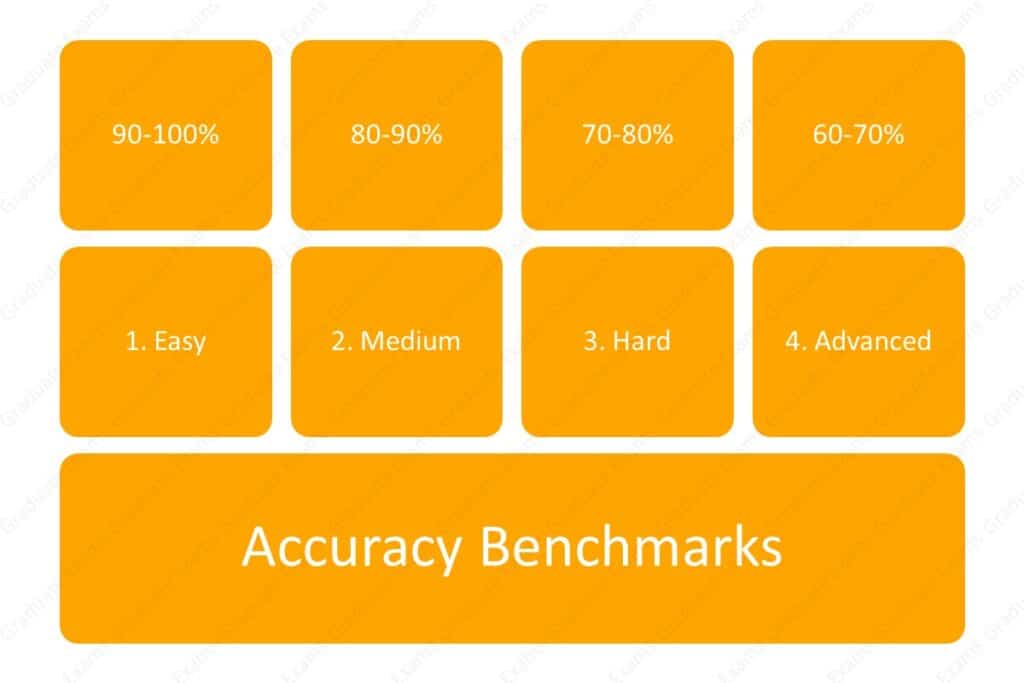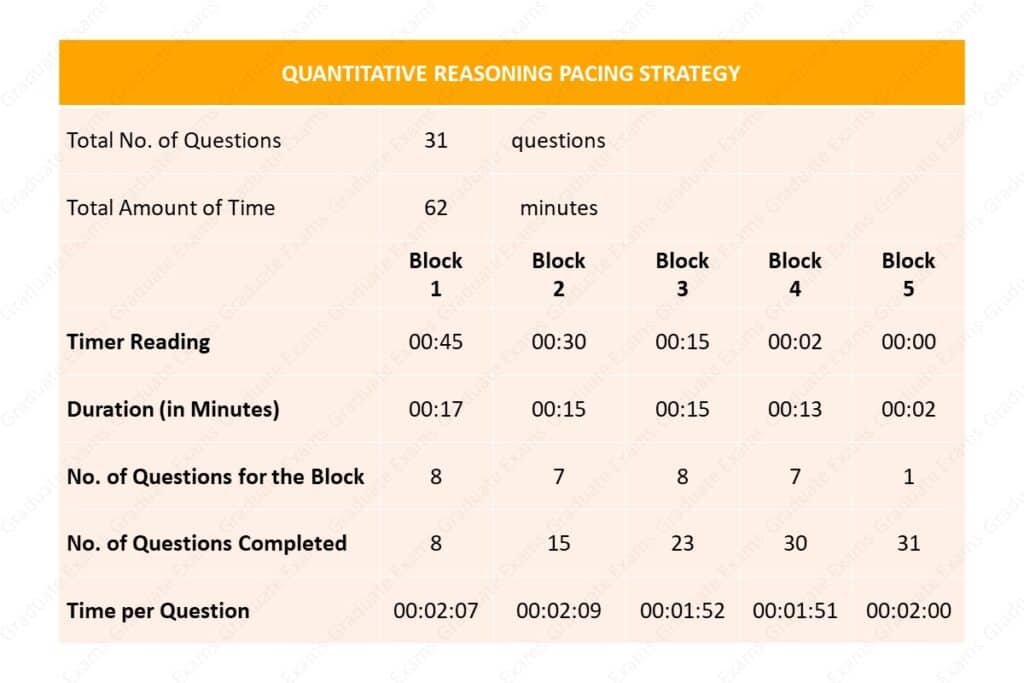I see a lot of people asking how hard is it to get 700 on GMAT. So, I decided to write this article to answer that question.
The answer comes from my experience of getting a 700+ score on GMAT twice and from helping others do the same.
How Hard Is It to Get 700 on GMAT?
In general, getting 700 on GMAT is hard. It requires an incredible amount of preparation and skill. You’ll need to solve tough math problems, apply advanced grammar rules, and extract meaning from dense text and data. 88% of people taking the GMAT score less than 700.
But many people miss the mark because they don’t apply GMAT-specific strategies that people who score 700 or more use. If you want to what these key strategies are, read on.
Understand and Take Advantage of GMAT Algorithm
GMAT algorithm is adaptive. The reason why it is so hard to get 700 is that you need to understand how to deal with this adaptive algorithm and then apply that knowledge.
In simple terms, GMAT’s adaptive algorithm picks the next question for you based on your performance in the previous questions.
People who score 700 on the GMAT prompt the algorithm to pick questions of high difficulty by displaying high accuracy in answering questions of low or moderate difficulty.
Therefore, if you answer 80-90% of the first 10-12 questions, the algorithm will consistently give you 700-level questions to tackle.
But if you’re not able to handle level-700 questions, the algorithm will go back to serving you easy to moderate questions.
Thus, you must become comfortable with answering hard and advanced questions.
Get Comfortable with Hard and Advanced Material
GMAT tests advanced application of grammar rules, mathematical principles, and analysis of dense text and data. To get to the 700+ level, you need to become comfortable with answering hard questions.
GMAT decided the difficulty of a question using data collected from test takers. Broadly speaking, the difficulty of a question depends on the percentage of people who answered the question correctly for each score.
For example:
A 670-level GMAT question is a question which 60-70% of the people who scored 670 answered correctly.
GMAT gathers the performance data from experimental questions. While taking the GMAT, up to 20% of the questions may be experimental. The experimental questions aren’t scored. The GMAT algorithm uses these questions to gather data.
But you will have no way of identifying these experimental questions because the algorithm randomly distributes these questions.
Another point is that the difficulty of a question corresponds to the score at which test takers have 60-70% accuracy. Therefore, the level at which you can answer 60-70% of the questions correctly will be your GMAT score.
Therefore, to score 700 on the GMAT, you should be able to maintain an accuracy of 60-70% for hard and advanced questions during test conditions.
Since you require an accuracy of 60-70% for tough questions, you can guess that you’ll require higher accuracy for moderate and easy ones.
To get a score of 700, you must demonstrate an accuracy if 90-100% for easy to moderate questions. Here are some benchmarks for accuracy according to difficulty.

One of the main reasons people don’t score 700 is because they miss many easy to moderate questions in the first 10-12 questions.
So, should you be extra cautious while answering the initial set of 10-12 questions? Well, if caution comes at the expense of time, then no.
This brings us to the next aspect – speed and pacing.
Work on Your Speed and Pacing
Speed and pacing may seem one and the same. But the two terms have different meanings in the context of GMAT.
Speed is the time you take to solve a problem of a given difficulty, in a question format, and from a specific topic.
For example:
Speed refers to how fast you can solve a hard data sufficiency question from geometry.
Pacing is the number of problems you should solve for pre-defined timestamps. GMAT uses a countdown timer to show you how much time you have remaining. Thus, important timestamps on the timer are – 45:00, 30:00, 15:00, and 2:00.
Pacing focusses on answering all the questions on the test. Answering all the questions in a section is important because the GMAT algorithm imposes a significant penalty for each question you don’t attempt.
Another reason why people struggle to score 700 on GMAT is because they don’t have a pacing strategy.
But you can do poorly on the GMAT even if you have a pacing strategy. Having a strategy is not enough. You must rehearse the strategy until it is second nature. To internalize the pacing strategy, you must take full-length practice tests.
Take Full-Length Practice Tests
Taking full-length practice tests can help you score 700 on GMAT because you can gauge your pace and speed, which are vital for scoring well on GMAT.
If you take practice full-length tests, you will be able to identify problems in your pacing strategy. You will know exactly when you have to speed up or slow down.
A full-length mock test, just like the real GMAT, has 31 questions in the quantitative reasoning section and 36 questions in the verbal reasoning section.
You get 62 minutes to answer the 31 questions in the quantitative reasoning section. For the 36 questions in the verbal reasoning section, you get 65 minutes. These time limits are also in line with the real GMAT’s timing for these sections.
Here’s an example of pacing strategy for the quantitative reasoning section.

But if you want a detailed explanation of pacing for other sections, you can read my article on how to keep track of time on GMAT.
Analyzing your performance after a full-length practice test will help you identify where your pacing needs work.
If you’re aiming for a 700+ score, I recommend taking 6 full-length practice tests. The Manhattan Prep Computer Adaptive Practice Exam is the best test series for full-length practice tests.
In addition to helping you with your pacing, full-length practice tests also help you identify areas of improvement. Addressing areas of improvement and overcoming your weaknesses produces quick gains in a short amount of time.
For this reason, people who score 700 or more on GMAT take the time to identify weaknesses.
Identify Areas of Improvement and Overcome Weaknesses
Analyzing your performance in full-length practice tests can help you score 700 on GMAT because these tests help you identify areas of improvement and weaknesses in your preparation.
Once you have identified your weaknesses, you can overcome them through topic-based quizzes, study, and revision. Overcoming these weaknesses improves your ability to answer difficult questions with quick and correct answers.
To identify an area of improvement, look for topics that meet the following criteria:
- Accuracy is below 50%
- Average difficulty of the questions is the lowest
- Average speed is more than 150 seconds per question
After each full-length practice test identify 1-2 topics for each section. Then, spend the next 4-7 days working on these topics. After that, take another full-length practice test.
The work you did between each full-length practice test may reveal new areas of improvement.
Taking full-length practice tests, analyzing the results, finding my weaknesses, and addressing those weaknesses played an major role in improving my GMAT score from 650 to 710. So, I recommend you use this process too.
But before you take any full-length practice test, you should have solved all the questions in the GMAT Official Guide and the GMAT Official Advanced Questions.
Solve Questions from Official GMAT Material
The GMAT Official Guide and the accompanying guides are the only source of real GMAT questions. Therefore, solving all the questions from these books creates a firm foundation for scoring 700 on GMAT.
When solving questions from the GMAT Official Guide you should pay attention to answer explanations because they provide a lot of valuable information about terms, concepts, formulas, rules, methods, approaches, and techniques.
Using the answer explanations, you can identify what you need to learn and internalize for performing well on the GMAT. However, the answer explanations don’t cover the topics in detail. The answer explanations contain only the information you need to answer the specific question.
In my article on how to use GMAT Official Guide, I offer more tips on making the most out of every question in the GMAT Official Guide. Do check it out for insights and advice.
For topic-wide coverage, you’ll need a GMAT-specific study guide.
Use a GMAT-Specific Study Guide
Like I said, the Official Guide only contains a fraction of the information you need to get a score of 700 or more on the GMAT. So, you’ll need a source that comprehensively covers quantitative reasoning and verbal reasoning topics.
If you search online for quant or verbal study guides, you will find plenty of resources. However, many of them aren’t specific to GMAT.
GMAT is a highly structured test. The test has been around for 70 years. And over the years, people have noticed patterns. For example, the critical reasoning questions on GMAT fall into 10-12 types.
In response to these patterns, people have created strategies and techniques. For instance, the PowerScore GMAT Critical Reasoning Bible has clear strategies for dealing with the 10-12 types of critical reasoning questions.
You will not find these GMAT-specific strategies in generic guides. Therefore, I recommend studying from prep material that is tailored to the needs of GMAT test takers.
However, even within the domain of GMAT specific content, finding sources for scoring 700 or more is difficult. So, I’ve created a post of the best GMAT resources. You can read the article for the top ten recourses I recommend for scoring more than 700 on GMAT.
Image Credits:
